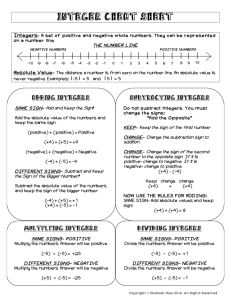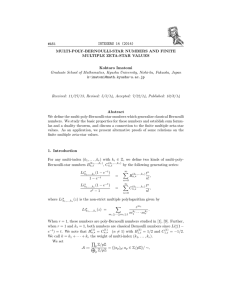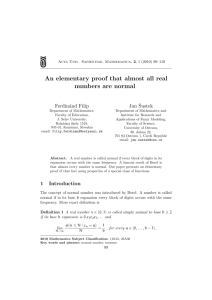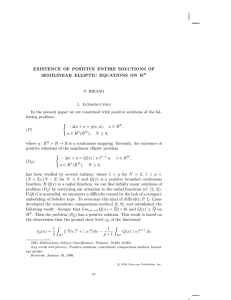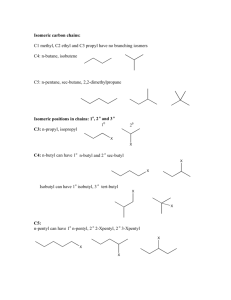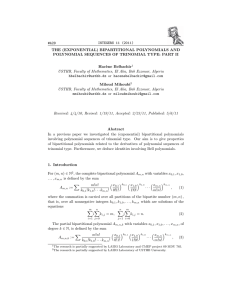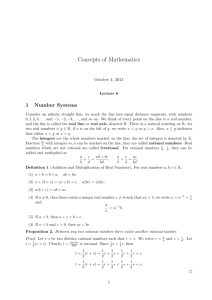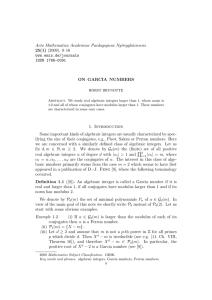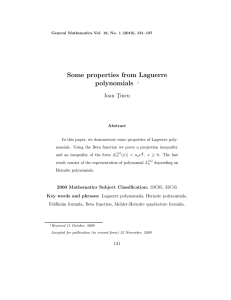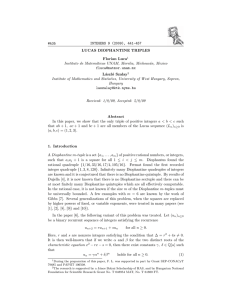INTEGERS 14 (2014) #A54 IDENTITIES BETWEEN POLYNOMIALS RELATED TO STIRLING AND HARMONIC NUMBERS
advertisement
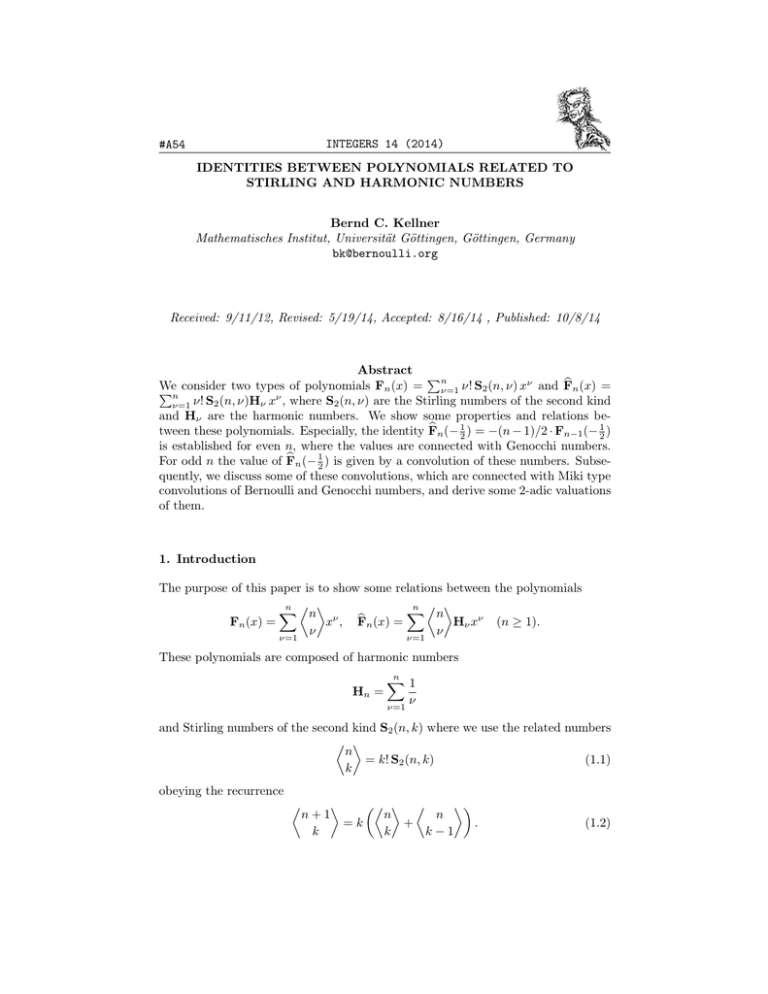
INTEGERS 14 (2014)
#A54
IDENTITIES BETWEEN POLYNOMIALS RELATED TO
STIRLING AND HARMONIC NUMBERS
Bernd C. Kellner
Mathematisches Institut, Universität Göttingen, Göttingen, Germany
bk@bernoulli.org
Received: 9/11/12, Revised: 5/19/14, Accepted: 8/16/14 , Published: 10/8/14
Abstract P
n
b n (x) =
We
consider
two
types
of
polynomials
Fn (x) = ⌫=1 ⌫! S2 (n, ⌫) x⌫ and F
Pn
⌫
⌫!
S
(n,
⌫)H
x
,
where
S
(n,
⌫)
are
the
Stirling
numbers
of
the
second
kind
2
⌫
2
⌫=1
and H⌫ are the harmonic numbers. We show some properties and relations beb n ( 1 ) = (n 1)/2 · Fn 1 ( 1 )
tween these polynomials. Especially, the identity F
2
2
is established for even n, where the values are connected with Genocchi numbers.
b n ( 1 ) is given by a convolution of these numbers. SubseFor odd n the value of F
2
quently, we discuss some of these convolutions, which are connected with Miki type
convolutions of Bernoulli and Genocchi numbers, and derive some 2-adic valuations
of them.
1. Introduction
The purpose of this paper is to show some relations between the polynomials
n ⌧
n ⌧
X
X
n ⌫
n
b n (x) =
Fn (x) =
x , F
H⌫ x⌫ (n 1).
⌫
⌫
⌫=1
⌫=1
These polynomials are composed of harmonic numbers
Hn =
n
X
1
⌫
⌫=1
and Stirling numbers of the second kind S2 (n, k) where we use the related numbers
⌧
n
= k! S2 (n, k)
(1.1)
k
obeying the recurrence
⌧
n+1
k
=k
✓⌧
⌧
◆
n
n
+
.
k
k 1
(1.2)
2
INTEGERS: 14 (2014)
⌦ ↵
Note that S2 (n, 1) = S2 (n, n) = 1 for n 1 and S2 (n, 0) = n0 = n,0 for n 0
using Kronecker’s delta. For properties of Stirling and harmonic numbers we refer
to [10]. The polynomials Fn are related to the Eulerian polynomials, see [6, pp. 243–
245] and [16], [19] for a survey. The numbers Fn (1) are called ordered Bell numbers
or Fubini numbers, cf. [6, p. 228]. For a discussion and further generalizations⌦ of↵
b n see [3] and [7], respectively. Note that the notation n
the polynomials Fn and F
k
is frequently used also for the Eulerian numbers, which we denote by A(n, k) as in
[6]; the notation Fn is used as in [16], [19].
Lemma 1.1. We have for n
1:
Fn ( 1) = ( 1)n ,
b n ( 1) = ( 1)n n,
F
Fn+1 (x) = (x2 + x)F0n (x) + xFn (x),
b n+1 (x) = (x2 + x)F
b 0 (x) + xF
b n (x) + xFn (x).
F
n
Proof. The recurrences follow easily by (1.2) and the values at x =
1 by induction.
The Bernoulli numbers Bn and the Genocchi numbers Gn may be defined by
B(t) =
et
and
G(t) =
et
X
tn
n!
(|t| < 2⇡)
(1.3)
X
2t
tn
=
Gn
+1
n!
(|t| < ⇡),
(1.4)
t
=
1
Bn
n 0
n 0
where G0 = 0 and Bn = Gn = 0 for odd n > 1, cf. [6, pp. 48–49]. Note that
Gn = 2(1
2n )Bn
(n
0).
(1.5)
The numbers Bn are rational, whereas the numbers Gn are integers.
Define the semiring S ⇢ Z[x], which consists of polynomials having nonnegative
integer coefficients. Further define the set
S↵ = {f 2 S : f (↵ + x) = ( 1)deg f f (↵
x) for x 2 R},
(1.6)
where such polynomials have a reflection relation around x = ↵. For f (x) = 0 we
declare deg f = 0, such that 0 2 S↵ is well defined.
Theorem 1.2. We have the following relations for n
(a)
Z 0
Fn (x)dx = Bn .
1
1:
3
INTEGERS: 14 (2014)
(b)
1
2)
Fn (
=
Gn+1
.
n+1
(c)
Fn (x)/x, (x + 1)Fn (x) 2 S
1/2 .
This theorem can be deduced from known results, which we will give later. By
Fn 2 S and the symmetry property (c) above, we conclude that Fn (x) > 0 and
( 1)n Fn ( 1 x) > 0 for x > 0; both expressions strictly increasing as x ! 1.
Except for a simple zero at x = 0, all real zeros of Fn symmetrically lie around
x = 12 in the interval ( 1, 0). For an illustration see Figure A.1. The value of
Fn ( 12 ) can be seen as a central value. Note also that x2 + x 2 S 1/2 occurs in the
b n given in Lemma 1.1. Interestingly, the integral over the
recurrences of Fn and F
interval [ 1, 0] and the central value are mainly connected with Bernoulli numbers.
b n as follows.
Similar properties also exist for the polynomials F
Theorem 1.3. We have the following relations:
(a)
Z 0
b n (x)dx = n Bn
F
2
1
(b)
b n(
F
(c)
b n(
ord2 F
1
2)
=
1
1
2)
n,1
n ✓ ◆
1 X n G⌫ Gn+1 ⌫
2 ⌫=1 ⌫ ⌫ n + 1 ⌫
n
=
(n
1
2
Fn
1
2)
1(
1).
(odd n
(even n
8
>
<ord2 n,
2(r 1),
>
:
ord2 (n + 1) + [log2 (n + 1)],
1).
2).
if even n 2,
if n = 2r 1 (r
otherwise,
where ord2 is the 2-adic valuation and [ · ] gives the integer part.
where
(f )
= ( 1)
b n(
F
(d)
(e)
1
2)
1
b n (x) = Fn (x) + (n
F
n,⌫
2S
1/2
1)xFn
+
n
X2
n,⌫ (x)F⌫ (x)
⌫=1
and deg
b n (x)/x
F
1 (x)
(n
n,⌫
=n
1)Fn
⌫ for ⌫ = 1, . . . , n
1 (x)
2S
where the resulting polynomial has degree n
1.
1/2
(n
2.
2),
(n
2),
1),
4
INTEGERS: 14 (2014)
The polynomials n,⌫ will be recursively defined later in Proposition 3.4. The
b n (x)/x (n 1)Fn 1 (x) is shown in Figure A.2. The first relations
symmetry of F
b n and Fn are given as follows.
between the polynomials F
Table 1.4.
b 1 (x) = F1 (x),
F
b 2 (x) = F2 (x) + xF1 (x),
F
b 3 (x) = F3 (x) + 2xF2 (x) + (x2 + x)F1 (x),
F
b 4 (x) = F4 (x) + 3xF3 (x) + 3(x2 + x)F2 (x) + (2x3 + 3x2 + x)F1 (x).
F
In the following theorem a di↵erent relation is given by derivatives of Fn .
Theorem 1.5. We have
b n (x) =
F
n
X
(⌫)
( 1)⌫+1
⌫=1
Fn (x) x⌫
⌫!
⌫
(n
1).
Remark. The identity (c) of Theorem 1.3 occurred in [13] as an important key step in
proofs. We shall use di↵erent approaches to prove the theorems in a comprehensive
way.
2. Bernoulli and Stirling Numbers
Define
Sn (m) =
m
X1
⌫n
(n
0).
⌫=0
It is well known that
Sn (x) =
1
(Bn+1 (x)
n+1
Bn+1 ),
(2.1)
where Bn (x) is the nth Bernoulli polynomial, cf. [10, p. 367], with the properties
B0n+1 (x) = (n + 1)Bn (x),
Bn (0) = Bn .
(2.2)
The Gregory-Newton expansion of xn reads
xn =
✓ ◆
n ⌧
X
n x
,
k
k
k=0
(2.3)
5
INTEGERS: 14 (2014)
which follows by (1.1) and the usual definition of the numbers S2 (n, k) by
xn =
n
X
S2 (n, k)(x)k
k=0
with falling factorials (x)k . The summation of (2.3) yields another familiar formula
✓
◆
n ⌧
X
n
x
Sn (x) =
.
(2.4)
k
k+1
k=0
⌦ ↵
Note that n0 = 0 for n 1 and k1 = ( 1)k . The following formula is a classical
result which is due to Worpitzky. We give a short proof.
Proposition 2.1 (Worpitzky [20, (36), p. 215]). We have
n ⌧
X
n ( 1)k
= Bn (n 1).
k k+1
k=1
Proof. Since Sn (0) = 0, we conclude by (2.1), (2.2), and (2.4) that
✓
◆ X
n ⌧
n ⌧
X
n
1
x 1
n ( 1)k
0
Bn = Sn (0) = lim Sn (x)/x = lim
=
.
x!0
x!0
k k+1
k
k k+1
k=0
k=1
A similar result with harmonic numbers is the following.
Proposition 2.2. We have
n ⌧
X
n
( 1)k
Hk
=
k
k+1
k=1
n
Bn
2
1
(n
1).
Proof. The derivative of (2.4) provides that
✓
◆X
n ⌧
k
X
n
x
1
Sn0 (x) =
= Sn (x)/x
k
k + 1 j=0 x j
xVn (x)
k=0
where
Vn (x) =
n ⌧
X
n
k=0
✓
◆ k
1
x 1 X 1
.
k k+1
k
j x
j=1
Since |Vn (0)| < 1 and Sn (x) xSn0 (x) ! 0 as x ! 0, we obtain by L’Hôpital’s rule
that
Sn (x) xSn0 (x)
xSn00 (x)
1 00
Vn (0) = lim
= lim
=
S (0).
2
x!0
x!0
x
2x
2 n
Using (2.1) and (2.2) we then derive that
n
Sn00 (x) = nBn 1 (x) and Vn (0) =
Bn 1 .
2
This shows the claimed identity.
6
INTEGERS: 14 (2014)
3. Symmetry Properties
b n . Note that the
We shall give some symmetry relations of the polynomials Fn and F
Eulerian numbers, as used in [6], [19], are symmetric such that A(n, k) = A(n, n k).
Recall the definition of S↵ in (1.6).
Lemma 3.1. The set S↵ has pseudo semiring properties. If f, g 2 S↵ , then
f · g 2 S↵ ,
f + g 2 S↵ ,
(⇤)
0
f 2 S↵ ,
where in case of addition and f · g 6= 0 a parity condition must hold such that
(⇤)
deg f ⌘ deg g
(mod 2).
If f has odd degree, then f (↵) = 0.
Proof. The cases, where f = 0 or g = 0, are trivial. Since S↵ ⇢ S, the pseudo
semiring properties follow by the parity of ( 1)deg f , resp., ( 1)deg g . If deg f is
odd, then f (↵) = f (↵), which implies that f (↵) = 0.
Proposition 3.2 (Tanny [19, (16), p. 737]). We have
Fn (x) =
n
X
A(n, k)xn
k+1
(x + 1)k
1
(n
1).
k=1
Corollary 3.3. We have
Fn (x)/x, (x + 1)Fn (x) 2 S
(n
1/2
1).
Proof. Using the symmetry of A(n, k), we obtain that
fn (x) := Fn (x)/x =
n
X
A(n, k)xn
k
(x + 1)k
1
= ( 1)n
1
fn ( (x + 1)).
k=1
Hence, fn ( 12 + x) = ( 1)n 1 fn ( 12 x) and deg fn = n
S 1/2 . Since x2 + x 2 S 1/2 , it also follows that
(x2 + x) · Fn (x)/x = (x + 1)Fn (x) 2 S
Proposition 3.4. We have for n
b n (x) =
F
1:
n
X
⌫=1
n,⌫ (x)F⌫ (x)
1 show that Fn (x)/x 2
1/2 .
7
INTEGERS: 14 (2014)
where
(
1,
n,⌫ (x) =
0,
if n = ⌫ = 1,
if ⌫ 2
/ {1, . . . , n},
otherwise recursively defined by
n+1,⌫ (x)
Furthermore
n,⌫
= (x2 + x)
2 S and deg
n,⌫
0
n,⌫ (x)
=n
+
n,⌫ 1 (x)
+
n,⌫ x.
⌫ for ⌫ = 1, . . . , n. Especially
n,n 1 (x)
= (n
1)x.
Proof. We use induction on n. For n = 1 we have
b 1 (x) = F1 (x) and
F
1,⌫ (x)
=
1,⌫ .
Now assume the result is true for n. By assumption we have
b n (x) =
F
b 0 (x) =
F
n
n
X
⌫=1
n
X
n,⌫ (x)F⌫ (x),
0
n,⌫ (x)F⌫ (x)
+
0
n,⌫ (x)F⌫ (x),
⌫=1
and by Lemma 1.1 that
b n+1 (x) = (x2 + x)F
b 0 (x) + xF
b n (x) + xFn (x),
F
n
(x2 + x)F0n (x) = Fn+1 (x)
xFn (x).
It follows that
b n+1 (x) = (x2 + x)
F
2
= (x + x)
n
X
⌫=1
n
X
0
n,⌫ (x)F⌫ (x)
0
n,⌫ (x)F⌫ (x)
⌫=1
+
+
0
n,⌫ (x)F⌫ (x)
n
X
⌫=1
n+1
X
n,⌫ (x) (F⌫+1 (x)
xF⌫ (x))
⌫=1
b n (x) + xFn (x)
+ xF
n
n
X
X
0
= (x2 + x)
(x)F
(x)
+
⌫
n,⌫
=
b n (x) + xFn (x)
+ xF
n,⌫ (x)F⌫+1 (x)
+ xFn (x)
⌫=1
n+1,⌫ (x)F⌫ (x).
⌫=1
Thus
n+1,⌫ (x)
= (x2 + x)
0
n,⌫ (x)
+
n,⌫ 1 (x)
+
n,⌫ x.
8
INTEGERS: 14 (2014)
In particular, we have
n+1,n+1 (x)
=
n,n (x)
=1
n+1,n (x)
=
n,n 1 (x)
(3.1)
and
The recurrence shows that
for 1 ⌫ < n that
deg
n+1,⌫
+ x = (n
1)x + x = nx.
(3.2)
2 S for ⌫ = 1, . . . , n + 1. Therefore we conclude
n+1,⌫
0
n,⌫ ,
= max(2 + deg
n,⌫ 1 )
=n
⌫ + 1.
Along with (3.1) and (3.2) this shows the claimed properties for n + 1.
Proposition 3.5. We have
n,⌫
2S
1/2
for n
2
⌫
1.
Proof. We make use of Proposition 3.4 and Lemma 3.1. For n
n+1,⌫ (x)
= (x2 + x)
0
n,⌫ (x)
+
1
⌫
1 we have
n,⌫ 1 (x).
We use induction on n. For n = 3 we have
3,1 (x)
= (x2 + x)
0
2,1 (x)
Now assume the result holds for n
n+1,⌫ (x)
since 0n,⌫ ,
otherwise
n,⌫ 1
n,⌫ 1
0
n,n 1 (x)
= x2 + x 2 S
2,0 (x)
3. For ⌫ = 1, . . . , n
= (x2 + x)
0
n,⌫ (x)
+
=n
= (x2 + x)(n
1 and
n,n 2
2S
1) +
1/2
2S
0
n,⌫
n,n 2 (x)
with deg
1/2 .
2 we have
n,⌫ 1 (x)
2 S 1/2 by assumption and 2 + deg
= 0. It remains the case ⌫ = n 1:
n+1,n 1 (x)
since
+
1/2 ,
= deg
2S
n,n 2
n,⌫ 1
if ⌫ 6= 1,
1/2 ,
= 2.
Corollary 3.6. We have
b n (x)/x
F
(n
1)Fn
1 (x)
where the resulting polynomial has degree n
2S
1/2
(n
2),
n
X2
n,⌫ (x)
1.
Proof. Propositions 3.4 and 3.5 show that
b n (x)/x
F
(n
1)Fn
1 (x)
= Fn (x)/x +
⌫=1
· F⌫ (x)/x,
(3.3)
where n,⌫ 2 S 1/2 and deg n,⌫ = n ⌫ for ⌫ = 1, . . . , n 2. By Corollary 3.3 and
Lemma 3.1 we conclude that n,⌫ (x) · F⌫ (x)/x 2 S 1/2 . Since the first term and
the products on the right-hand side of (3.3) lie in S 1/2 having the same degree
n 1, the left-hand side of (3.3) also lies in S 1/2 and has degree n 1.
9
INTEGERS: 14 (2014)
b n (x)/x 2
While Fn (x)/x 2 S 1/2 for n
1, we have F
/ S 1/2 for n
2;
compare values at x = 0 and x = 1 using Lemma 1.1. The latter function needs
a correction term to lie in S 1/2 . For an illustration of the symmetry of Fn (x)/x
b n (x)/x (n 1)Fn 1 (x) see Figures A.1 and A.2.
and F
4. Generating Functions
Let [tn ] be the linear operator, that gives the coefficient of tn of a formal power
series, such that
X
f (t) =
an tn , [tn ] f (t) = an ,
n 0
see [10, p. 197]. Define htn i = n![tn ]. Let (hn (x))n
Then we denote by
X
tn
Gh(x, t) =
hn (x)
n!
0
be a sequence of functions.
n 0
the two-variable exponential generating function, such that
htn i Gh(x, t) = hn (x).
Recall the definitions of B(t) and G(t) in (1.3) and (1.4), respectively. We further
set
e
e
B(t)
= B(t)/t, G(t)
= G(t)/t,
and
e0 = G
e 0 = 0,
B
e n = Bn /n,
B
e n = Gn /n (n
G
1).
e
Lemma 4.1. The function y(t) = G(t)
satisfies the Bernoulli di↵erential equation
y0 + y =
1 2
y ,
2
which is equivalent to
(log y)0 =
1
y
2
1.
Proof. Both equations are identical due to (log y)0 = y 0 /y and are verified by y(t) =
2/(et + 1).
Corollary 4.2. We have
e
G(t)
=
X
n 0
n
e n+1 t
G
n!
n
1X
e
ent
log G(t)
=
( 1)n G
2
n!
n 1
(|t| < ⇡),
(4.1)
(|t| < ⇡).
(4.2)
10
INTEGERS: 14 (2014)
Proof. Eq. (4.1) follows by its definition. Integrating the right-hand side di↵erential
equation of Lemma 4.1, we derive that
◆
Z ✓
1e
1 X e tn
e
log G(t)
=
G(t) 1 dt =
Gn
t+C
2
2
n!
n 1
e
en = G
en
with a constant C. Since log G(0)
= 0, we obtain C = 0. Note that ( 1)n G
e
e
e
for n 2 and G1 = 1. With t G1 /2 t = t G1 /2 we finally get (4.2).
We also have a connection with hyperbolic functions, where we casually obtain
the known coefficients of the following function by (4.2).
Lemma 4.3. We have
Proof. This follows by
t/2
e
✓ ◆
t
log cosh
.
2
t
2
e
log G(t)
=
✓ ◆
t
et + 1
e
cosh
=
= G(t)
2
2
b 0 (x) = 1 and
Proposition 4.4. Define F0 (x) = F
have
(a)
GF(x, t) =
1
,
(x, t)
(b)
b t) =
G F(x,
log (x, t)
,
(x, t)
Z
Z
1
.
(x, t) = 1
GF(x, t)dx =
b t)dx =
G F(x,
x(et
1). Then we
e log (x, t),
B(t)
1e
2
B(t) (log (x, t)) .
2
e
Proof. Set u = et 1. Note that 1/u = B(t)
and 1 xu =
following generating functions (cf. [10, p. 351]):
X ⌧n tn
t
k
(e
1) =
,
k n!
(x, t). We need the
(4.3)
n k
log(1 t) X
=
Hn tn .
1 t
(4.4)
n 1
(a) Using (4.3) we obtain that
1
1
x(et
1)
=
X
t
(x(e
k 0
k
1)) =
X
k 0
X ⌧n tn
X
tn
x
=
Fn (x) = GF(x, t).
k n!
n!
k
n k
n 0
(4.5)
11
INTEGERS: 14 (2014)
We further deduce that
Z
Z
GF(x, t)dx =
dx
=
1 xu
log(1 xu)
=
u
e log (x, t).
B(t)
b t) is similarly derived
(b) First substitute t by x(et 1) in (4.4). The result for G F(x,
as in (4.5) with an additional factor Hk . The integral follows by
Z
log(1 xu)
log(1 xu)2
dx =
.
1 xu
2u
Proposition 4.5. We have
e n+1 (n 1),
=G
8 1
,
>
>
< 2n 1 e
b n( 1 ) =
2 Gn ,
F
2
n
P
>
n e e
>
1
:2
⌫ G⌫ Gn+1
1
2)
Fn (
if n = 1,
if even n
⌫,
if odd n
2,
3.
⌫=1
Proof. From Proposition 4.4 we conclude that
(
1
2 , t)
=
Hence,
GF(
1
2 , t)
By (4.1) we derive that
Fn (
et + 1
e
= G(t)
2
e
b
= G(t)
and G F(
1
2)
= htn i GF(
1
2 , t)
Similarly, we obtain that
b n(
F
1
2)
b
= htn i G F(
1
2 , t)
1
2 , t)
1
.
e log G(t).
e
= G(t)
e
e n+1 .
= htn i G(t)
=G
e log G(t)
e
= htn i G(t)
= cn ,
e
where cn arises from the convolution sum caused by the Cauchy product of G(t)
e
and log G(t).
By means of (4.1) and (4.2) we achieve that
n ✓ ◆
1X n
e ⌫G
e n+1
cn =
( 1)⌫ G
2 ⌫=1 ⌫
⌫.
e ⌫ = 0 for
Case even n: The indices ⌫ and n + 1 ⌫ have di↵erent parity. Since G
e 1 = 1, the sum simplifies to
odd ⌫ > 1 and G
✓ ✓ ◆
✓ ◆
◆
1
n e e
n e e
n 1e
cn =
G1 Gn +
Gn G1 =
Gn .
2
1
n
2
12
INTEGERS: 14 (2014)
Case odd n: For n = 1 we compute c1 =
parity of the indices, we finally infer that
cn =
by omitting the factor ( 1)⌫ .
Proposition 4.6. We have
Z 0
Fn (x)dx = Bn
and
Z
0
1
b n (x)dx =
F
Proof. Using Proposition 4.4, we obtain that
fore
Z 0
0
e log (x, t)
GF(x, t)dx = B(t)
0
1
b t)dx =
G F(x,
1e
2
B(t) (log (x, t))
2
3. Because of the same
⌫
n
Bn
2
(0, t) = 1 and
x= 1
1
Z
Let n
n ✓ ◆
1X n e e
G⌫ Gn+1
2 ⌫=1 ⌫
1
and
1
2.
0
(n
1
( 1, t) = et . There-
e
= B(t)t
= B(t)
x= 1
=
1).
1e
B(t)t2 =
2
t
B(t).
2
Since the integrals above are independent of t, the operator htn i commutes with
integration. Applying htn i to these equations easily yields the results.
Remark. The generating function GF(x, t) can be found in [19, (9), p. 736] and [3,
(3.14), p. 3853]. The value of Fn ( 12 ) was posed as an exercise in [10, 6.76, p. 559]
and also given in [3, (3.29), p. 3855]; see [18, p. 288] for a short proof using the
theory of Riordan arrays.
5. Convolutions
We use the notations
n ✓ ◆
X
n
(↵r + s ) =
↵r+⌫
⌫
⌫=0
n
{↵r +
n
s}
=
n
X
↵r+⌫
s+n ⌫ ,
(n, r, s
0)
s+n ⌫
⌫=0
for symmetric binomial, resp. usual convolutions of two sequences (↵⌫ )⌫ 0 and
( ⌫ )⌫ 0 . Unless otherwise noted, we generally assume n
1 for convolutions in
this section. We first need a simple lemma (cf. [9, p. 82]).
13
INTEGERS: 14 (2014)
Lemma 5.1. If n
1 and r, s
0, then
= (↵r + s+1 )n 1 + (↵r+1 + s )n
1
1
(e
↵0 + e0 )n = (e
↵0 + 0 )n + (↵0 + e0 )n ,
n
n
(↵r +
n
s)
where for the second part ↵0 = ↵
e0 =
⌫ 1.
0
1
,
= e0 = 0 and ↵
e⌫ = ↵⌫ /⌫, e⌫ =
Proof. The first part follows by n⌫ = n ⌫ 1 +
1/(⌫(n ⌫)) = 1/(n⌫) + 1/(n(n ⌫)).
n 1
⌫ 1
⌫ /⌫
for
, the second part by the identity
The Euler polynomials En (x) are defined by
X
2ext
tn
=
E
(x)
n
et + 1
n!
(|t| < ⇡).
(5.1)
n 0
Compared to (1.4) and (4.1), formulas with En (x) are naturally transferred to
e n+1 . The well-known identity ([15,
Genocchi numbers by the relation En (0) = G
(17), p. 135], [11, (51.6.2), p. 346])
(E0 (x) + E0 (y))n = 2(1
x
y)En (x + y) + 2En+1 (x + y)
leads to basic convolutions of the Genocchi numbers
e1 +G
e 1 )n = 2G
e n+2 + 2G
e n+1 ,
(G
e1 +G
e 2 )n = G
e n+3 + G
e n+2 ,
(G
(5.2)
(5.3)
where the latter equation is derived by Lemma 5.1. Note that (5.2) also follows
immediately by Lemma 4.1 and (4.1). More general convolution identities can be
found in [5] for Bernoulli and Euler polynomials, that cover some known convolutions as special cases.
As a result of Proposition 4.5 in the last section, the convolution
e0 +G
e 1 )n =
(G
1 e
e 0 )n+1
(G0 + G
2
(5.4)
has appeared, which resists a simple evaluation for odd n > 1; the right-hand
side follows by Lemma 5.1. We shall give some arguments in the following that
this remains an open problem. Convolutions with di↵erent indices in the shape of
e1 + G
e k )n for k 1 are discussed in [2] and [1],
(Gj + Gk )n for j + k 0 and (G
respectively. A connection with the last-mentioned convolutions is established by
the following lemma.
14
INTEGERS: 14 (2014)
Lemma 5.2. If n
1, then
e0 +G
e 1 )n =
(G
n
X
e1 +G
e k )n
(G
k
.
k=1
Proof. By Lemma 5.1 we obtain the recurrences
e0 +G
e k )n
(G
k+1
e0 +G
e k+1 )n
= (G
k
e1 +G
e k )n
+ (G
k
e0 +G
e n+1 )0 = 0, this gives the claimed sum.
for k = 1, . . . , n. Since (G
e 0 (x) = 0 and
However, this will not simplify (5.4), see below. As before, we set B
e
Bn (x) = Bn (x)/n (n 1) for the Bernoulli polynomials. We can translate (5.4) as
follows.
Lemma 5.3. We have
1 e
e 0 )n = (B
e0 + B
e 0 )n
(G0 + G
4
e0 + B
e 0 ( 1 ))n
2n (B
2
(n
1).
e ⌫G
e n ⌫ /4 = (1 2⌫ 2n ⌫ + 2n )B
e ⌫B
e n ⌫ . It is well
Proof. By (1.5) we have G
1
1 n
known that Bn ( 2 ) = (2
1)Bn . Observing the symmetry, the result follows
n ⌫
n 1 e
n 1 1 ⌫
e ⌫ = 2n 1 B
e ⌫ ( 1 ).
from (2
2
)B⌫ = 2
(2
1)B
2
Proposition 5.4 (Gessel [9, (12), p. 81]). If n
n e
e 0 (x)}n
{B0 (x) + B
2
e 0 + B0 (x))n = Hn
(B
1, then
1 Bn (x)
+
n
Bn
2
1 (x).
For x = 0 this reduces to Miki’s identity [14, Theorem, p. 297]:
For x =
1
2
e0 + B
e 0 }n
{B
e0 + B
e 0 )n = 2Hn B
e n + Bn
(B
1.
this gives the Faber-Pandharipande-Zagier identity [8, Lemma 4, p. 22]:
n e 1
e 0 ( 1 )}n
{B0 ( 2 ) + B
2
2
e 0 + B0 ( 1 ))n = Hn
(B
2
1
1 Bn ( 2 )
+
n
Bn
2
1
1 ( 2 ).
e0 +G
e 0 )n is mainly transferred to (B
e0 + B
e 0 )n , (B
e 0 + B0 ( 1 ))n , and
Note that (G
2
e 0 ( 1 ))n by Lemmas 5.3 and 5.1. The Miki type convolutions above show
(B0 + B
2
that one can replace binomial convolutions by usual convolutions, but this does not
lead to a simplification compared to (5.2).
Agoh showed the formula below for k 3 in a slightly di↵erent form. In view of
(5.2) and (5.3) this is also valid for k = 1, 2.
Proposition 5.5 (Agoh [1, Theorem, p. 61]). If k, n 1, then
✓
◆
e1 +G
e k )n = 2 G
e n+k B
e kG
e n+1 + 1 (B0 + G
e n+1 )k .
(G
k
15
INTEGERS: 14 (2014)
As an application we derive a di↵erent Miki type convolution as follows.
Proposition 5.6. For n 1 we have
✓
n
e
e
e n+1 1 G
e n + Gn
(G0 + G1 ) = 2 Hn 1 G
2
e0 + G
e 2 }n
{B
1
e0 + G
e 2 )n
+ (B
1
◆
.
Proof. The case n = 1 is trivial, let n 2. We combine Lemma 5.2 and Proposie 0 = 0 and B0 = 1. We then
tion 5.5, where we split the summations. Note that B
obtain that
where
e0 +G
e 1 )n = G
en +
(G
S1 = (n
e n,
1)G
S2 =
n
X1
k=1
e1 +G
en
(G
n
X1
k=1
e kG
e n+1
B
k
k)
k
=
e n + 2(S1 + S2 + S3 ),
=G
e0 + G
e 2 }n
{B
1
,
◆
k ✓ ◆
n
k ✓
X1 X
1X k
k 1 e e
e
e
S3 =
B⌫ Gn+1 ⌫ = Hn 1 Gn+1 +
B⌫ Gn+1 ⌫
k ⌫=0 ⌫
⌫ 1
k=1
k=1 ⌫=1
n
X1 ✓n 1◆
e
e ⌫G
e n+1 ⌫ = Hn 1 G
e n+1 + (B
e0 + G
e 2 )n 1 .
= Hn 1 Gn+1 +
B
⌫
⌫=0
n
X1
Summing up the terms establishes the result.
As a result of Section 3, we have yet another formula.
Proposition 5.7. For odd n > 1 we have
0
e0 +G
e 1 )n = 2 B
e n+1 +
(G
@G
where the polynomials
n,⌫
2S
1/2
n
X2
n,⌫ (
⌫=1
odd ⌫
1
C
1 e
2 )G⌫+1 A ,
are defined as in Proposition 3.4.
Proof. By Propositions 3.4 and 3.5 we have
b n (x) = Fn (x) + (n
F
1)xFn
1 (x)
+
n
X2
n,⌫ (x)F⌫ (x),
⌫=1
where n,⌫ 2 S 1/2 . Along with Proposition 4.5 we derive the result by setting
e ⌫+1 = 0.
x = 12 and omitting the terms where G
16
INTEGERS: 14 (2014)
The last two propositions show that one can resolve the convolution in (5.4) by
e0 +G
e 1 )n =
(G
e
n+1 Gn+1
+
e
n 1 Gn 1
+ ··· +
e
2 G2
(odd n > 1)
with some coefficients ⌫ , but this is again unimproved compared to the convolution
itself. Either the coefficients ⌫ are connected with Bernoulli numbers or with
polynomials that have to be recursively computed.
6. p-Adic Analysis
Let Zp be the ring of p-adic integers and Qp be the field of p-adic numbers. Define
ordp x as the p-adic valuation of x. Define [x] as the integer part of x 2 R.
Lemma 6.1 ([17, p. 37]). If n
ordp
n
X
x⌫
⌫=0
1, then
(x⌫ 2 Qp ),
min ordp x⌫
0⌫n
where equality holds, if there exists an index m such that ordp xm < ordp x⌫ for all
⌫ 6= m.
Lemma 6.2 ([17, p. 241]). If n
1, then
ordp n! =
n
p
sp (n)
,
1
where sp (n) is the sum of the digits of the p-adic expansion of n.
e n are p-adically interesting for p = 2, whereas the
For even n > 0 the numbers G
numbers Gn are odd integers.
e n 2 Q2 \Z2 , while G
e n 2 Zp for p > 2.
Proposition 6.3. For n 2 2N the numbers G
e
More precisely, ord2 Gn = ord2 n and ord2 Gn = 0.
Proof. Let n 2 2N. It is well known that the tangent numbers (cf. [10, p. 287])
2n (1
e n = 2n
2n )B
1
en
G
are integers, here defined with di↵erent sign. The right-hand side follows by (1.5).
e n are p-integers for p > 2. For p = 2 we derive that
Hence the numbers G
e n = ord2 (2B
e n) =
ord2 G
ord2 n,
where we have used the fact that ord2 (2Bn ) = 0, which follows by the von StaudtClausen theorem, see [12, Theorem 3, p. 233]. Since n is even, we infer that
e n 2 Q2 \Z2 . By the same arguments, it
ord2 n < 0 and consequently that G
follows from (1.5) that ord2 Gn = 0.
17
INTEGERS: 14 (2014)
e0 + G
e 0 )n for even n. We
It remains of interest to evaluate the convolution (G
n
e
e
will see that the 2-adic valuation of (G1 + G1 ) has a simple form, while the 2-adic
e0 +G
e 0 )n is more complicated.
valuation of (G
Proposition 6.4. Let n
1 and m = [n/2]. Then
e1 +G
e 1 )n =
ord2 (G
ord2 (m + 1).
Proof. By (5.2) it follows that
e1 +G
e 1 )n = 1 + ord2 (G
e n+2 + G
e n+1 ) =: 1 + g,
ord2 (G
e n+2 or G
e n+1 vanishes. Note that n + 2 = 2(m + 1) for even n
where either G
and n + 1 = 2(m + 1) for odd n. We conclude that g = ord2 (2(m + 1)) using
Proposition 6.3, which gives the result.
Proposition 6.5. We have
8
>
<1,
n
e
e
ord2 (G0 + G0 ) = 1 ord2 (n 1),
>
:
1 ord2 n [log2 n] + 2!2 (n),
if n = 1,
if odd n 3,
if even n 2,
where !2 (n) = 1, if n is a power of 2, otherwise !2 (n) = 0.
e 1 = 1 and G
e 2 = 1.
Proof. The cases n = 1, 2, 4 are handled separately with G
2
e0 +G
e 0 )n = 2nG
e n 1 by symmetry and di↵erent parity of
For odd n 3 we have (G
indices. The result follows by Proposition 6.3. Now, let n even and n 6. We first
obtain by Lemma 5.1 that
e0 +G
e 0 )n = 2 (G
e 0 + G0 )n .
(G
n
(6.1)
Set I = {2, 4, . . . , n 2} and L = [log2 n] !2 (n). Further define `2 (x) as the number
of digits of x 2 N in base 2. Note that ord2 n⌫ = s2 (n) + s2 (⌫) + s2 (n ⌫) by
Lemma 6.2. With the help of Proposition 6.3 and Lemma 6.1, we can evaluate
e 0 + G0 )n and obtain that
ord2 (G
X ✓n◆
e ⌫ Gn ⌫
ord2
G
s2 (n) + min s2 (⌫) + s2 (n ⌫) ord2 ⌫ .
(6.2)
⌫2I
⌫
⌫2I
We will show that there is only one minimum on the right-hand side to get equality.
To be more precise, this takes place for ⌫m = 2L , the greatest power of 2 in I, where
we have
s2 (⌫m ) + s2 (n ⌫m ) ord2 ⌫m = 1 + s2 (n 2L ) L.
(6.3)
We have now to distinguish between two cases, whether n is a power of 2 or not.
18
INTEGERS: 14 (2014)
Case n = 2L+1 : The right-hand side of (6.3) reduces to 2
⌫ 2 I {⌫m } that
2 L < s2 (⌫) + s2 (n ⌫) ord2 ⌫,
L. We derive for
since 2 s2 (⌫) + s2 (n ⌫) and L < ord2 ⌫ by construction.
Case n 6= 2L+1 : One observes that `2 (n) = `2 (⌫m ). Regarding (6.3) we then
conclude that 1 + s2 (n 2L ) L = s2 (n) L. As above, for ⌫ 2 I {⌫m } we have
✓ ◆
n
ord2 ⌫ L < 0 ord2
,
⌫
which is equivalent to
s2 (n)
L < s2 (⌫) + s2 (n
⌫)
ord2 ⌫.
Both cases show that we have exactly one minimum. Thus (6.2) becomes
X ✓n◆
e ⌫ Gn ⌫ = s2 (n) + s2 (⌫m ) + s2 (n ⌫m ) ord2 ⌫m =: M,
ord2
G
⌫
⌫2I
where we compute in case n = 2L+1 that
M=
s2 (n) + 2
L=1
L=
[log2 n] + 2!2 (n),
otherwise !2 (n) = 0 and
M=
s2 (n) + s2 (n)
L=
L=
[log2 n] + 2!2 (n).
Together with (6.1) this gives the result.
7. Proofs of Theorems
Proof of Theorem 1.2. (a) We have two proofs either by Proposition 2.1 or by
Proposition 4.6. (b) This is shown by Proposition 4.5. (c) This is given by Corollary 3.3.
Proof of Theorem 1.3. (a) We have two proofs either by Proposition 2.2 or by
Proposition 4.6. (b) This is given by Proposition 4.5. (c) We have two di↵erent methods. The first proof is derived by Proposition 4.5. Second proof: For even
n we then obtain by Corollary 3.6 and Lemma 3.1 that
for x =
1
2.
b n (x)/x
F
(n
1)Fn
1 (x)
=0
(d) For even n we get by Propositions 4.5 and 6.3 that
b n(
ord2 F
1
2)
=
en =
1 + ord2 G
1
ord2 n.
19
INTEGERS: 14 (2014)
For odd n we derive by Propositions 4.5, 6.5, and Eq. (5.4) that
✓
◆
✓
◆
1 e
1 e
n
n+1
1
b
e
e
ord2 Fn ( 2 ) = ord2
(G0 + G1 )
= ord2
(G0 + G0 )
2
4
= 1 ord2 (n + 1) [log2 (n + 1)] + 2!2 (n + 1).
If n + 1 = 2r with r
1, then the latter expression simplifies to 1 2(r 1),
since ord2 (n + 1) = [log2 (n + 1)] = r and !2 (n + 1) = 1 in that case; otherwise
!2 (n + 1) vanishes. (e) This is a consequence of Propositions 3.4 and 3.5. (f) This
is Corollary 3.6.
To prove Theorem 1.5 we have to introduce some transformations. The Hadamard
product ([6, pp. 85–86]) of two formal series
X
X
f (x) =
a⌫ x⌫ , g(x) =
b⌫ x⌫
(7.1)
⌫ 0
⌫ 0
is defined to be
(f
g)(x) =
X
a⌫ b⌫ x⌫ .
⌫ 0
For a sequence (sn )n
0
its binomial transform (s⇤n )n
s⇤n
0
is defined by
n ✓ ◆
X
n
=
( 1)k sk .
k
k=0
Since the inverse transform is also given as above, we have (s⇤⇤
n )n 0 = (sn )n 0 , see
[10, p. 192]. The following transformation is due to Euler ([4, Ex. 3, p. 169]), where
we prove a finite case.
Proposition 7.1. If f, g are polynomials as defined in (7.1), then the Hadamard
product is given by
X
g (⌫) (x) ⌫
(f g)(x) =
( 1)⌫ a⇤⌫
x .
(7.2)
⌫!
⌫ 0
Pn
Proof. We may assume that f · g 6= 0. Let N = deg g. Define gn (x) = ⌫=0 b⌫ x⌫
where gN (x) = g(x). We use induction on n up to N . For n = 0 we have
(f
g0 )(x) = a⇤0 g0 (x) = a0 b0 .
Now assume the result holds for n
0. Since gn+1 (x) = bn+1 xn+1 + gn (x), we
20
INTEGERS: 14 (2014)
consider the di↵erence of (7.2) for n + 1 and n. Thus
(f
gn+1 )(x)
(f
n+1
X
bn+1 (n + 1)⌫ xn+1
⌫!
⌫=0
n+1
X ✓n + 1◆
= bn+1 xn+1
( 1)⌫ a⇤⌫
⌫
⌫=0
gn )(x) =
( 1)⌫ a⇤⌫
⌫
x⌫
= an+1 bn+1 xn+1
showing the claim for n + 1.
Proof of Theorem 1.5. The binomial transform
n ✓ ◆
X
1
n
=
( 1)k Hk
n
k
(7.3)
k=1
is well known, cf. [10, pp. 281–282]. Using Proposition 7.1 with f (x) =
b n , gives the result by means of (7.3).
and g = Fn , where f g = F
Pn
A. Figures
Figure A.1: Functions Fn
Fn (x)/x with n = 8 (dashed blue line), Fn (x)/x with n = 7 (red line).
⌫=1
H⌫ x⌫
21
INTEGERS: 14 (2014)
bn
Figure A.2: Functions F
b n (x)/x with n = 8 (dashed blue line),
F
b
Fn (x)/x (n 1)Fn 1 (x) with n = 8 (red line).
Acknowledgments. We are grateful to the anonymous referee for valuable suggestions and motivating to extend and improve the results; also for giving reference
[18].
References
[1] T. Agoh, On Bernoulli numbers II, Sichuan Daxue Xuebao 26 (1989), 60-65.
[2] T. Agoh, K. Dilcher, Convolution identities and lacunary recurrences for Bernoulli numbers,
J. Number Theory 124 (2007), 105–122.
[3] K. N. Boyadzhiev, A series transformation formula and related polynomials, Int. J. Math.
Math. Sci. 23 (2005), 3849–3866.
[4] T. J. Bromwich, An introduction to the theory of infinite series, Macmillan, London, 1908.
[5] W. Chu, R. R. Zhou, Convolutions of Bernoulli and Euler polynomials, Sarajevo J. Math.
6, no. 2, (2010), 147–163.
[6] L. Comtet, Advanced Combinatorics, D. Reidel, Dordrecht, 1974.
[7] A. Dil, V. Kurt, Polynomials Related to Harmonic Numbers and Evaluation of Harmonic
Number Series I, Integers 12 (2012), Article A38.
[8] C. Faber, R. Pandharipande, Hodge integrals and Gromov-Witten theory, Invent. Math. 139
(2000), 173-199.
[9] I. M. Gessel, On Miki’s identity for Bernoulli numbers, J. Number Theory 110 (2005),
75–82.
[10] R. L. Graham, D. E. Knuth, O. Patashnik, Concrete Mathematics, 2nd edition, AddisonWesley, Reading, MA, USA, 1994.
INTEGERS: 14 (2014)
22
[11] E. R. Hansen, A table of series and products, Prentice Hall, Englewood Cli↵s, New Jersey,
1975.
[12] K. Ireland, M. Rosen, A Classical Introduction to Modern Number Theory, 2nd edition,
GTM 84, Springer–Verlag, 1990.
[13] B. C. Kellner, On quotients of Riemann zeta values at odd and even integer arguments, J.
Number Theory 133 (2013), 2684-2698.
[14] H. Miki, A relation between Bernoulli numbers, J. Number Theory 10 (1978), 297-302.
[15] N. E. Nørlund, Mémoire sur les polynomes de Bernoulli, Acta Math. 43 (1920), 121–196.
[16] H. Prodinger, Ordered Fibonacci partitions, Canad. Math. Bull. 26 (1983), 312–316.
[17] A. M. Robert, A Course in p-adic Analysis, GTM 198, Springer–Verlag, 2000.
[18] R. Sprugnoli, Riordan arrays and combinatorial sums, Discr. Math. 132 (1994), 267–290.
[19] S. M. Tanny, On some numbers related to the Bell numbers, Canad. Math. Bull. 17 (1975),
733–738.
[20] J. Worpitzky, Studien über die Bernoullischen und Eulerschen Zahlen, J. Reine Angew.
Math. 94 (1883), 203–232.
